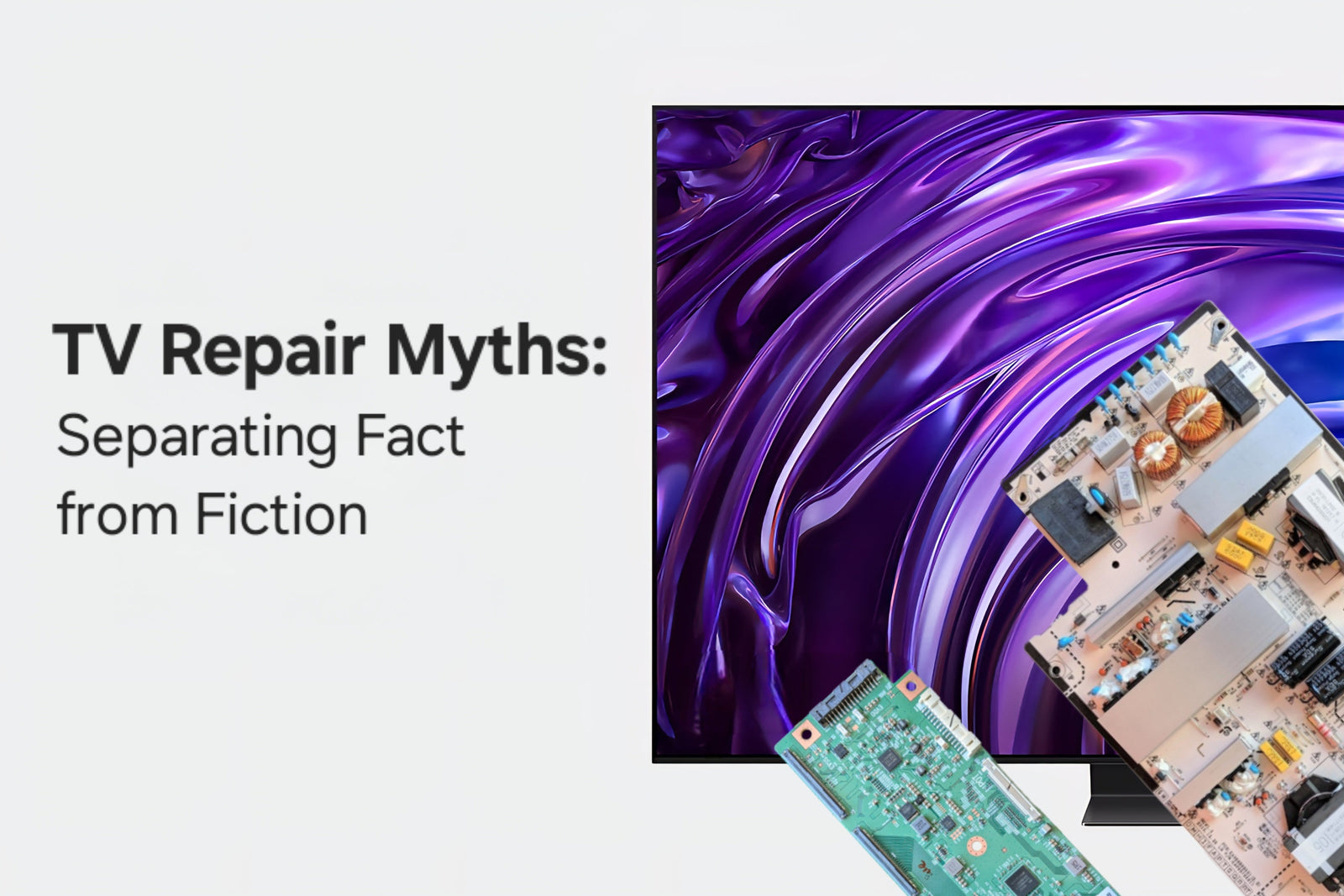When your TV starts acting up, it’s easy to fall into the trap of common myths and misinformation. But don’t toss your TV to the curb just yet, many so-called "facts" about TV repair are outdated, exaggerated, or downright wrong. In this guide, we’re busting the biggest myths about TV repair and showing you how to make smarter, more sustainable choices. 💡
Would you rather watch a video on how to get started instead? Check out our helpful YouTube video below:
Why Do These Myths Stick Around?
Many TV repair myths linger because of outdated information and good ol’ fashioned urban legends. Years ago, TVs were harder to repair, but technology has come a long way. Now, with improved designs and a wealth of online repair guides, even DIY solutions are within reach for many users.
Peer-to-peer stories also fuel the fire, one bad repair experience can turn into a cautionary tale, discouraging others from trying. Add in the temptation of flashy new TVs and easy online shopping, and the idea of repairing can seem like a hassle. But the truth is, today’s repairs are often easier, faster, and more cost-effective than you might think.
TVpartsToday Tip: Don’t believe everything you hear! TV technology has evolved and so have repair options. Always look at your specific issue before deciding.
The Real Impact of Misinformation
Misinformation isn’t just annoying, it can be costly and wasteful. Here's why:
- Tossing out a TV with a minor issue contributes to growing electronic waste
- A simple Google search like “Sony tv repair” may lead to a mix of helpful and harmful advice
- Believing repairs are too pricey may lead to avoidable replacements... or worse, botched DIY attempts
TVpartsToday Tip: Always double-check your sources and consult with trusted repair services or guides before taking action.
Common TV Repair Myths (And the Truth!)
Myth 1: "It’s Always Cheaper to Buy a New TV"
Not always! While new TVs are more affordable now, repairing a minor issue, like replacing a faulty capacitor or swapping out a circuit board, is usually cheaper than replacing the entire unit. Plus, your older TV may have better specs or sentimental value.
TVpartsToday Tip: Compare repair costs and the specs of your current TV before jumping to replace it. You might be surprised at how much you save!
Myth 2: "All Repairs Require a Pro"
Sure, some problems need professional attention, but many don’t! Swapping out a remote battery, checking input sources, or tightening a loose cable connection are all quick fixes anyone can handle. Swapping out a circuit board? That's easy, too! So easy, in fact, most in the industry consider the process "plug 'n' play"!
Myth 3: "DIY Repairs Are Too Complex"
Think again! Thanks to online tutorials and a growing community of DIY tech enthusiasts, fixing common issues is easier than ever. Need a new T-Con board or power supply? You can find guides and parts for brands like Sony, Sanyo, and Sceptre with just a few clicks.
TVpartsToday Tip: Start with simple troubleshooting, many fixes require nothing more than a screwdriver and some YouTube tutorials!
Busted Myths, Real Facts
Fact 1: Many TV Problems Are Easy to Fix
Loose cable? Remote not working? Wrong input? These are beginner-level fixes that can save you time and money.
Fact 2: Professional Repairs Can Be Worth It
Need deeper diagnostics? A trained technician can identify and fix complex issues quickly, often for less than a new TV. Plus, many services come with warranties for peace of mind.
How to Approach TV Problems Wisely
Identify the Issue
Start by recognizing the signs. A flickering screen? Might be the backlight or power board. No sound? Could be the main board. Use keywords like “element tv parts” or “sceptre tv parts replacement” to find matching guides and replacement parts. Our website also offers a host of information for you to use to help your repair process!
Final Thoughts
Don’t fall for outdated TV repair myths. Whether it’s a small fix you can handle yourself or a bigger issue best left to professionals, being informed can help you save money, reduce waste, and keep your favorite screen going strong.
TVpartsToday Tip: Visit our website for replacement parts, DIY guides, and expert insights to take the mystery out of TV repair.
Need Help?
If you’re still unsure about the issue or need to replace a part, reach out to TVpartsToday. We can help you identify the exact cause of the problem and provide the right replacement part!
Would you rather watch a video? Check out our helpful Troubleshooting 101 playlist over on YouTube!
Would you rather chat with a seasoned repair expert? Head on over to our TVRepairHelp subReddit!
Need help finding the right board or part?
Call us at 930-212-1975 or browse our inventory online.
DIY-friendly parts, fast shipping, and expert support – only at TVpartsToday.

